Name
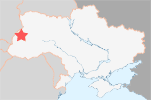
| ||
| Lviv (L'vov) |
Львів (L'viv) is the Ukrainian name - with the appropriate Transcription in Latin. The Russian version Львов (L'vov) is also quite common, but only used outside L'viv! Other spellings include 'Lwiw', 'Lviv' and 'Lvov'. Thanks to the Habsburg reign, there's also a quite common German name: 'Lemberg'. As with the name, it's better to use the Ukrainian version when in L'viv (the apostrophe marks the so-called 'soft sign - ь'). 'Lvov' is the Polish and Russian version of the name, and some people do not really like the Russians and Poles (but it seems to get better). There's even a Latin name: "Leopolis".
Location
L'viv is the centre of the Western Ukraine and main town of a province with the same name.
Population
Slightly more than 800,000 inhabitants.
History
L'viv was the capital of the historic province Galicia (Galicia-Wolhynia resp.), which covered present-day Western Ukraine, Eastern →Poland and even a small part of →Slovakia. Galicia should not be confused with a province bearing the same name in Spain! Galicia has never been an independent country but a part of the Kingdom of Poland from the 14th century until 1772. After that, Galicia became the north-easternmost province of the →Austria-Hungarian monarchy. After the defeat of Austria-Hungary in 1918 and heavy fights between Ukrainians and Poles, the city became a part of Poland again. After 1939, Galicia suffered a lot and was often invaded by Germans and Russians. Finally it was divided into a Polish part and an Ukrainian (respectively Soviet Union) part. The situation was quite dramatic. Galicia was famous for its multicultural society: Poles, Ukrainians, Jews, Germans, Russians, Tatars, Armenians, Greeks and Frenchmen just to name but a few lived together more or less harmonically. Needless to say that religious diversity was corresponding with the population.
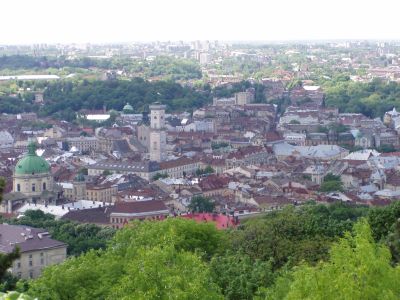
| ||
| The old town as seen from the 'High Castle' |
Everything fell apart after 1918. Ukrainians fought against the Poles and vice versa. After 1939, Germans annihilated the Jewish population almost completely (before WW II, almost one quarter of L'viv's population was Jewish!). After the war, all Germans were brutally expelled. Next, ethnic cleansing started all over Galicia. Ukrainians were brutally expelled from the Polish part and Polish people expelled from the Ukrainian part. Additionally, Stalin deported many minorities. Today, L'viv and its surrounding can be considered the 'most Ukrainian' part of the country. Everyone speaks Ukrainian - when you talk in Russian, chances are high that you will be frowned. Recently there's a tendency towards normalisation of the Ukrainian-Polish relationship.
L'viv itself was founded in the middle of the 13th century by a Galician king and was named after his son 'Lev', dering from the Latin word 'leo', which means lion. Hence the lion in the city's crest. The fact that there's a hill inside the town, atop of which a fortress protecting the city could be built, helped the town to develop quickly and gain importance (see picture on the right and information on the 'High Castle' below). Eversince L'viv was the capital of Galicia province. Especially during the Habsburg reign, the town prospered. Although Galicia had to face a very hard time between 1918 and 1945, the town was not heavily damaged during the war. Considering the suffering of its citizens, it's almost a miracle.
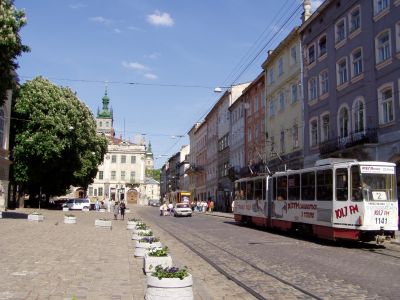
| ||
| The market square of L'viv - not even one new building disturbs the atmosphere |
The historic core of L'viv is quite small and everything is within walking distance, although seeing all sights of the town means to walk for many hours. L'viv is more than it's charming old town. The outskirts consist of huge industrial areas and not very attractive, old and grey housing areas. Citizens of L'viv have to fight an old problem remaining from the Habsburg era. Most of the town's infrastructure including the water supply had been installed around the year 1900. Unfortunately, nothing had changed except for the enormous growth of the population and the town itself. The sewage system and the water supply are hopelessly overloaded, and so long-term measures had to be taken. That is why there's only water from 6 to 9 in the morning and, to make it easier to remember, from 6 to 9 in the evening. Sometimes the water is even hot. It doesn't seem to be a unique thing - restricted use of water is also a problem in the old Habsburg city →Sighetu Marmaţiei.
The entire historic centre of L'viv has been declared World Cultural Heritage by the UNESCO and is loaded with interesting sights. Therefore only some short comments on several attractions:
Getting there / transportation
L'viv has good train connections - even to →Poland, →Slovakia, →Hungary and Russia. There are numerous trains to the capital →Kyiv (Kiev). To the latter, it's 540 km, which takes 11h and costs around €7 in a compartment. Trains to the Southwest crossing the Carpathian mountains run as far as →Uzhhorod at the Slovakian border. The train needs 7½ hours to cover the 300 km, the fare is €4 in a compartment. The route is very scenic. Note that trains running to Hungary and beyond do not stop in Uzhhorod!
L'viv features include 13 theatres and philharmonic orchestras, 20 museums and exhibitions, 22 institutes and academies, 63 churches and 2 synagogues. Quite a lot for a city with only slightly more than 800,000 inhabitants. Many visitors compare L'viv with other popular towns like →Prague or Krakow. Comparable or not - one difference is quite obvious: The lack of tourists. In Prague and Krakow, one will see more tourists than inhabitants in the centre of town. In L'viv, except for large Polish groups, there are only very few visitors. This will change in the near future - L'viv is getting increasingly popular.
просп. Свободи (Prosp. Svobodi)
The medieval centre of town is clearly defined by the Prospekt Swobodi (Liberty avenue) in the west. The word 'prospekt' is often used in Slavic countries and means that it's a very wide road. Liberty avenue features a long park in the middle of the street. Here, all the expensive hotels and restaurants line up. The park itself is very popular with the locals. Inside the narrow stretch, a strange monument dedicated to the Ukrainian poet and national hero Taras Shevchenko attracts the visitors attention. In many western Ukrainian towns, Lenin monuments had to give way to Shevchenko monuments.
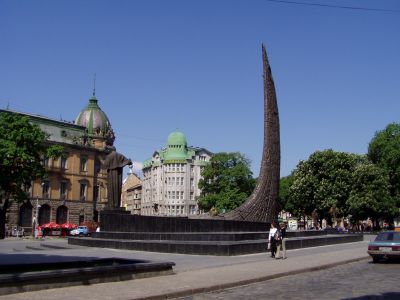
| ||
| The Swobodi avenue - Lviv's most expensive boulevard with an interesting monument in the middle |
Театр Опери та Балету ім. І. Франка (Teatr Operi ta baletu im. i. Franka)
Ivan Franko is another Ukrainian hero and was honoured by naming an entire city (Ivano-Frankovsk) and many institutions after him. Among them is L'viv's biggest Opera, called Theatre for opera and ballet 'Ivan Franko' at the north side of above-mentioned Liberty ave. The building itself was completed in 1900 and offers a fantastic interior and exterior. According to the schedule, many internationally famous musicians perform at this Opera. The square in front of the Opera seems to be a popular meeting place.
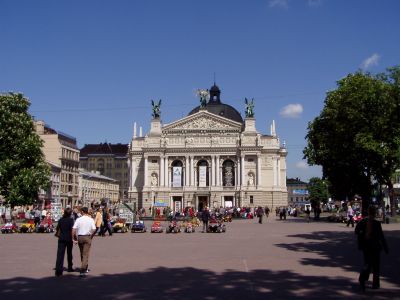
| ||
| The famous opera of L'viv |
Пл. Ринок (Pl. rinok)
When you walk east from Liberty ave., passing several cafés, you will enter the historic core and eventually end up at central Ploshadj Rynok (market square). Although the absolute centre of town, it's rather quiet. In the middle of the square, the large city hall towers the centre of town. The vicinity of the city hall includes many beautiful buildings from the 16th century, among them numerous museums. Personally, I liked building No 4 at the east side of the square very much. It's pitch-black and houses the Historic Museum of L'viv.
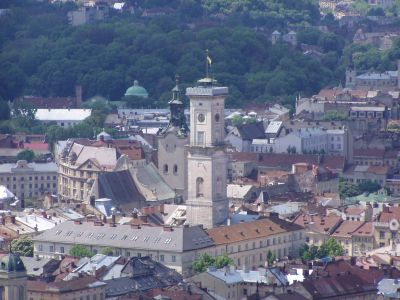
| ||
| The historic centre: Market square with the city hall in the middle and the cathedral left behind it |
At the north-east corner, the chemist's museum sells so-called 'iron wine', which is supposed to be good for health. I didn't want to try it, and so I gave it to friends as a souvenir. There are still alive, so it seems to be okay. The whole historic ensemble surrounding the market square is well preserved and offers a nice view of the town's history.
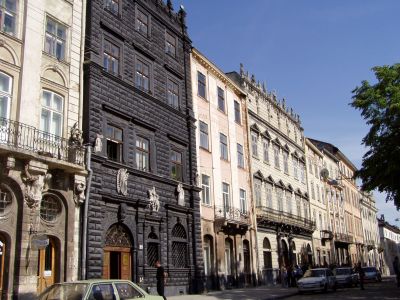
| ||
| This pitch-black house at the market square is my personal favourite |
Латинський кафедральний Собор
(Latinskii Kafedralnii Sobor)
Another landmark of the city centre can be found at the south-west corner of the market square. The Latin Cathedral is a huge church built during the time, when Galicia was part of the Kingdom of Poland around the 14th and 15th century. Eversince it's a Roman-Catholic church and therefore quite a rarity in L'viv: 22 churches are Ukrainian-Orthodox, 34 are Greek-Catholic and another 5 churches are protestant. Take your pick!
Домініканський Собор (Dominikanskii Sobor)
Talking about churches - sooner or later, everyone will find oneself standing in front of the Dominican church at the eastern edge of the old city. It features a large, green dome and therefore it's easy to spot (see also picture on the top right). During communist times, the church was misused as a museum on 'Atheismus and Religions'. (Un)fortunately the exhibiton has vanished - I would really like to see it. For a front view of the church, see picture below. Next to the cathedral stands another monument dedicated to Ivan Fedorov. It shows him reading a book. And so it doesn't come as a surprise that old books are sold around the monument. South of the church, parts of the reconstructed medieval city wall can be seen.
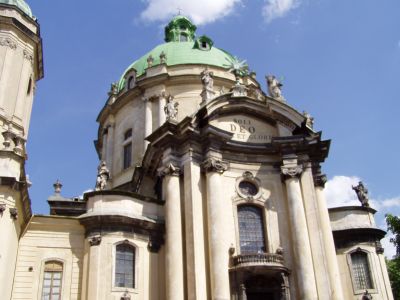
| ||
| Main entrance of the baroque Dominican church |
Високий Замок (Visokii Zamok)
The perfect place for enjoying the vista of the old town is Vyisokii Zamok (High castle) atop a green hill north of the centre. It takes around 15 minutes on foot to get there. The hill is not very big, however a huge antenna on the top makes it easy to spot. Once there was a fortress standing atop the hill protecting the town. The fortress was built in the 13th century and therefore it's the oldest part of L'viv, but little is left. There's a small platform on the 400 m high hill. The view is not limited to the historic centre - you can also see the vast suburbs and even the summits of the Forest Carpathian Mountains in the south. The hill get's overcrowded pretty soon when the weather is good.
Вірменський Собор (Virmenskii Sobor)
If you've got the feeling that you'd like to know how it is to be in →Armenia, the Armenian Church would be the perfect place. It's located north of the Market Square at the corner of Armenian and Galician road. As already mentioned above, there was even an Armenian minority living in L'viv (in fact, the Armenian diaspora is very big and can be found almost everywhere). The church was built in the 14th century and had been reconstructed recently. The reopening took place in May 2003, with many Armenian-Orthodox priests attending. It's possible to step inside and admire an original Armenian House of God - Armenian churches are completely different to other churches
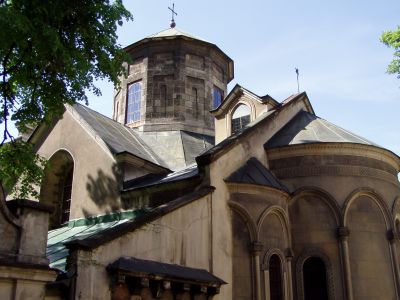
| ||
| There's even a beautiful Armenian church which has been reconstructed recently |
Личаківське кладовище (Lichakivske Kladovishtshe)
The Lyczakovski- (Lichakivske) cemetary east of the town centre is very impressive and shouldn't be missed. The cemetary is huge, hilly and green. Once you are inside, it's very easy to get lost. This great place lets the visitor reminisce about the past of multicultural Galicia: Thousands of graves of Ukrainians, Russians, Poles, Austrians, Slovakians, Hungarians, Germans etc show one thing - death is no respecter of persons. There are also many graves of famous people. Many tombs and vaults are real masterpieces. Almost everything is overgrown, and so one cannot deny a certain morbid charme of the place.
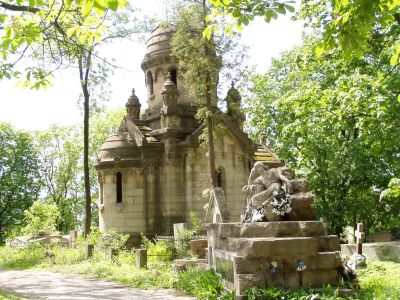
| ||
| Quiet moments at overgrown Litchakiv cemetary |
The cemetery is taken care of and still in use. Monuments, family vaults, simple iron crosses and much more cover several hectares. Visitors soon forget about the time. I've noticed that some tombs had been damaged. Most of them were Russian tombs, with gravestones knocked down or faces (there's often a picture of the the deceased) scratched. The Galician way of coming to terms with the past? I hope not. At least Poles were allowed to create a monument for the victims of the war between Poles and Ukrainians in 1918/19. Outside the cemetary, there are large, flat steps with the names of many thousand war victims engraved.
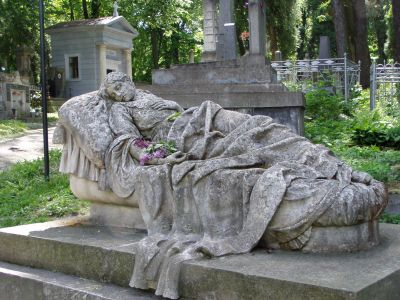
| ||
| One of the marvellous sculptures at Litchakiv cemetary. Almost each gravestone is a masterpiece |
Everyone has to pay an admission fee at the main entrance, but no one controls the tickets, since there are countless unguarded side entrances. I guess they badly need the many for preserving the place. Visitors will seldomly be alone - busloads of older Polish people head for the cemetary.
More than the above mentioned attractions, the city itself is simply moving. L'viv is a modern and vibrant city on the one hand, but an old and pleasant place on the other hand. Having been to the Ukraine without having been to L'viv is worth nothing... This is another Ukraine and cannot be compared with other places such as →Odessa, →Kiev or the →Crimea.
We stayed at a friend's place, so I can't recommend any hotels personally. But there are plenty of them, mostly in the old town and between the train station and the centre.
- www.lviv.ua/web/ Useful website about Lviv, incl. an English version.
- www.guide.lviv.ua/ Another useful guide with plenty of addresses - in English.
Do you have or do you know a good website about Lviv? Don't hesitate, let me know! After checking it, I would love to add it to the link list. You can submit a link by using the →contact form. Note that commercial websites will be treated differently.
©2024 Europe-East.com

 Albania
Albania Ukraine
Ukraine